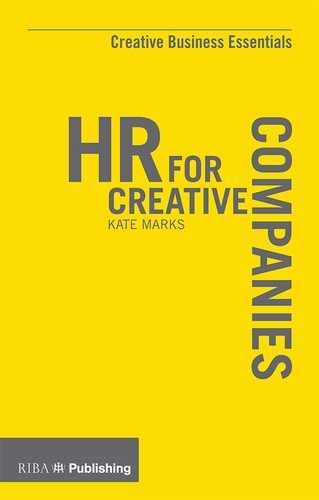Introduction
The premise behind this book is that human resources (HR) and creative companies can work well together. Gone are the days when there was perhaps a lack of mutual understanding. Over the past few years, people have come to realise that HR can be a positive force within a creative company.
In the past, it was suggested that creativity would be hampered by the rules and regulations, restrictive procedures and narrow-minded approach of the HR practitioners. Clearly, historically, this may be the fault of the HR professionals themselves. But I propose that it is rare that a conflict is the fault of one party alone. The challenges of recent years have meant that HR can be seen in a more positive light as a true support and a valuable asset for companies in the increasingly competitive marketplace.
In this book I intend to show how HR and creative companies can work well together. HR can and should be a support to all companies and can enhance the very creativity that HR may perhaps have limited or hindered in the past. I also use the book to illustrate how the architecture profession has evolved and is still evolving in its attitude and approach to people management.
In Chapter 1, I give a brief overview of the architecture profession. The variety of forms in which architecture is practised mirror those of other creative companies. In turn, the form in which you choose to work will affect the way you interact with HR: what your needs might be and how those needs could be fulfilled. Not every company needs a full blown HR department. It’s all about what support you need and where you can find it.
As I discuss in Chapter 2, it is only relatively recently that HR has been accepted as a profession as such; and HR itself comes in many forms. It’s important that you give some thought to the best structure of HR for your particular company and, in this chapter, I have tried to provide some insight into what the options may be.
Each following chapter focuses on a different aspect of the ‘employee lifecycle’. Even though an employee’s time with a company is a continuum, it is easier to illustrate – from an HR perspective – if it is divided into sections. So, each chapter has a particular emphasis. These reflect the path that an employee might take, from first joining the company to their possible departure. Each chapter is intended to be of practical use rather than simply expounding theoretical models. Where possible, I’ve used case studies and notes to illustrate and enhance the key points.
You will notice that the chapters dealing with the start and end of the employee lifecycle with your company are the largest. As I’ll discuss in more detail in Chapters 3 and 7, the interaction with the marketplace at these points is so important that it is essential to get it right. There are many considerations to be aware of and which will affect your own actions and behaviour. I’ve endeavoured to make these as clear as possible. Chapters 4, 5 and 6 all cover different aspects of people management once your employee is safely ensconced in your studio or office. How to keep the ones who are an asset to your company, how to manage those who may not be –in essence, helping you towards the goal of having the right people in the right place at the right time.
This book is not about dumbing down HR, but making it more user friendly. As a creative professional you do not need to be an HR expert, but you will benefit from being aware of the possibilities available to help you run a business that gets the best out of your most important and expensive investment – your people.
Creative companies themselves are very often small and medium-sized enterprises (SMEs) founded by one or two talented individuals who wish to pursue their own path and establish their own brands. I agree with the CEO of a major industry body who said recently that SMEs are the engines of growth: they are the future of the UK economy.
The effects of the economic downturn since 2008 on creative companies have been massive across the board. This is true of interior design, architecture, graphic design, fashion, media, film, animation or any other of the myriad of creative ventures that the UK sprouts. Different industries may have suffered or have been affected in different ways, but all have been driven to consider their approach to work and to their competitors, and in doing so, their people.
The challenges of the past largely centred around how the necessary procedural aspects of HR can possibly, fruitfully and positively be married with the creative process. It is my belief that true creativity needs some element of grounding to flourish, certainly within a commercial context.
HR can provide that grounding and support. As a function, it manages your reputation in the marketplace, it manages risk in the respect of potential legal challenge and it enables you to attract the brightest and best talent to enhance your creativity and serve your clients better.
Yes, possibly, this is ‘HR Utopia’ that I’m describing. But it is no less possible for all that.
This book will focus on certain broad themes. It is not intended to be a list of rules and regulations or a series of procedures. It is written with an awareness of the creative mind, and tries to tread a delicate path between the need for certain structure, and the flexibility to exercise true creativity.
LOOK OUT FOR THESE ICONS
![]() For more information
For more information
![]() See appendices
See appendices
